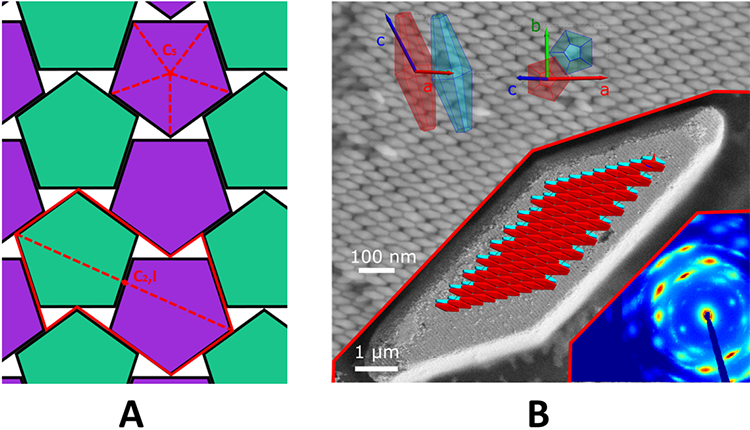The optimal assembly of identical objects is a question of geometry that has fascinated scientists since antiquity. Nowadays, it can be revisited in the science of nanomaterials, which allows the synthesis of nanoparticles with a great deal of control over their shape.
Scientists from the LPS (CNRS/Université Paris-Saclay), ICS (CNRS/Université de Strasbourg), SOLEIL (SWING beamline) and CIC nanoGUNE (San Sebastian, Spain) have demonstrated that gold bipyramids of symmetry 5 form a triclinic lattice, the lowest possible symmetry for a crystal.
This work, published in the journal Advanced Materials, opens up the prospect of applications for the synthesis of nanomaterials with novel symmetries.
Since the seminal work of Johannes Kepler, it has been known that 5-symmetric objects such as regular pentagons have a special place in geometry problems. In fact, they cannot completely fill a plane on their own (see Figure 1A), but must be combined with other geometric shapes. This led much later to the discovery of quasi-crystals of symmetry 5.
By making it possible to synthesise nanoparticles with a very high degree of control over their shape, the recent science of nanomaterials offers a new angle for understanding these geometric issues.
Among the nanoparticle morphologies with the most promising optical properties, gold bipyramids with 5-symmetry are currently under intense scrutiny because their tips allow to strongly modulate their optical response. Thanks to a thorough control of their morphology (elongated nanoparticles with pointed tips and a pentagonal base), scientists from the LPS, the ICS, the SWING beamline and the CIC nanoGUNE, have succeeded in crystallising these nanoparticles and elucidating their stacking mode: they have shown that these gold bipyramids form a triclinic lattice, the lowest possible symmetry for a crystal.
This loss of symmetry can be understood through an analogy with the optimal stacking of regular pentagons in the plane (Figure 1A): the individual objects have fifth-order rotational symmetry, but they pair up to create a centre of inversion I. In doing so, they reduce their symmetry to a minimum. In doing so, they reduce their rotational symmetry to order 2.

Figure 1:
A) Diagram showing the optimum stacking of regular pentagons in the plane. Top: representation of the 5th order symmetry axis (C5, in red) for a pentagon. Bottom: representation of a centre of inversion I and an axis of symmetry of order 2 (C2) for two assembled pentagons.
B) comparison between the model and the experiment. Top: diagrams of the assembly of two bipyramids (blue/red), in lateral and top views, as predicted numerically. Bottom: scanning electron microscopy image of this 'supercrystal', with the model (in colour) added on top. Bottom right: 2D SAXS (small angle X-ray scattering) image of some supercrystals - obtained on SWING.
In the experimentally obtained crystals, the bipyramids of pentagonal cross-section associate in a very similar way, with two particles per unit cell (blue and red in Figure 1B) in a triclinic structure, generalising the stacking mode of regular pentagons to three dimensions. This result was obtained by X-ray scattering on the SWING beamline and by electron microscopy at the LPS. Numerical simulations reproduce the symmetry and density of the stacking, confirming that this is the most compact solution possible.
Moreover, due to this crystalline order, bipyramid crystals have an optical response influenced by the crystal faces. Indeed, using the surface enhanced Raman scattering technique (SERS*), the analysed crystals give a more or less intense signal depending on whether the observed face is pointed or flat. Because of this optical phenomenon, these bipyramid crystals could find applications for the SERS detection of very low concentration compounds.
These results are an example of the meeting of nanochemistry and geometry, through fruitful back and forth between synthesis, characterisation and modelling. They shed experimental light on a difficult problem of optimum stacking of polyhedra, here elongated pentagonal bipyramids, and lead to the production of nanomaterials with novel symmetry, potentially usable in Raman spectroscopy for their optical properties.
* Raman spectroscopy allows to identify the chemical composition and structure of molecular systems, whether they are in solid, liquid or gas form; but it is not a very sensitive technique (very weak signal for low concentration samples). The surface enhanced Raman scattering (SERS) technique overcomes this limitation: the presence of a nano-structured metal surface amplifies (enhances) by several orders of magnitude the intensity of the Raman response of molecules present close to the metal surface; this allows the detection of molecules at very low concentrations.
